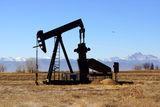States Test Fracking Regulations
Colorado is the latest state to implement new laws

States with a high interest in the oil and gas
industries are stepping up their attempts to
regulate the drilling process. The aim, in all
cases, is to minimize environmental fears while
creating jobs and wealth. Colorado, for example, is
the latest test case, although some communities
there are opposed to gas drilling.
The state has joined others such as California,
Illinois and Pennsylvania in its attempt to oversee
the hydraulic fracturing process used to break free
the oil and gas from the rocks where they are sealed
far beneath the earth’s surface. As for
Colorado, it will use infrared cameras to
detects leaks in its pipeline system, which is
costly but which is needed to ensure local
communities that they are safe. The oil and gas
industry estimates that 110,000 jobs there are tied
to those pursuits.
Nevertheless, four Colorado communities recently
rejected attempts to allow such fracking, or
drilling: Boulder, Fort Collins and Lafayette, were
three. Two of those were already off limits, says
the Colorado Oil and Gas Association. But the town
of Broomfield also voted no, by a 17-vote margin,
which means it will recount the ballots. It put a
five-year moratorium on any drilling.
“Boulder and Lafayette were nothing more than
symbolic votes. Lafayette’s last new well permit was
in the early 1990’s and Boulder’s last oil and gas
well was plugged in 1999. This election represents
round one with many more rounds to come. These
elections mobilized community members to educate
their neighbors, and our support of their efforts is
just beginning,” says Tisha Schuller, chief
executive of the
Colorado Oil and Gas Association.
There are more than 1 million wells fractured in the
United States and there has been little credible
evidence of water contamination, she adds. Colorado
has the most comprehensive set of groundwater
samples with over 2,000 wells tested in the San Juan
Basin that demonstrate that hydraulic fracturing
doesn’t pollute groundwater. She adds that numerous
studies support such a thesis, notably ones from
Yale and the
University of Texas.
She points to the current U.S. energy secretary and
Obama’s former EPA administrator, as well as
Colorado’s governor, all of whom say that fracking
can be done safely and the resulting gas finds would
lessen greenhouse gas emissions. That’s because
natural gas is cutting into coal’s marketshare.
"While our carbon emissions have been dropping, our
economy has been growing. Our businesses have
created 7.8 million new jobs in the past 44 months.
It proves that the old argument that we can't
strengthen the economy and be good stewards of our
planet at the same time is a false choice,"
President Obama said in his weekly address to
the nation this week.
Happy Middle
Illinois, meanwhile, is considered to have among the
toughest laws regulating the shale gas drilling
process. That law, signed earlier this year,
requires the wastewater that returns to the top
after sites are explored must be stored in tanks.
That is as opposed to open pits. If the tanks don’t
have enough room, the water can then go into those
pits before it would be reinjected underground.
Environmentalists want clearer rules on the size of
the tanks as well as under what emergencies
producers could store their overflow in such open
areas. Industry, which must now test the water for
impurities at every stage of production, says that
it can rise to the occasion and that gas exploration
could begin next year.
California, too, will allow access to its
Monterey Shale formation. It stretches from Central
California down through Southern California and
holds 15.4 billion barrels of recoverable crude oil,
says the U.S. Energy Information Administration.
California now produces nearly 10 percent of the
nation’s oil, which is on par with that of Alaska.
And next year, the Monterey Shale formation is open
for business, although producers must gain permits
and notify local communities, while also revealing
the chemicals that they are using to frack. A year
after the law has been in force, independent
scientists will thoroughly evaluate its performance.
Furthermore,
Pennsylvania is set to become the nation’s
second leading natural gas producer this year. In
2011, it was seventh. The
papers in Pittsburgh are reporting that the
shale gas sector now employs 46,644 people in its
metropolitan area. Its drillers produced1.5 trillion
cubic feet of natural gas in the first half of this
year, which will double by year-end and which is up
58 percent from a year ago.
Finding that optimal point whereby communities are
adequately protected and simulteneously, jobs and
prosperity flourish is often a difficult task. While
many green groups would say that the pace is too
fast, most states with shale resources are giving
their citizens a chance to cash in on the boom, with
much-needed safeguards.
Twitter: @Ken_Silverstein
Copyright © 1996-2013 by CyberTech, Inc. All rights reserved.
To subscribe or visit go to: http://www.energycentral.com
To subscribe or visit go to: http://www.energybiz.com
http://www.energybiz.com/article/13/11/states-test-fracking-regulations